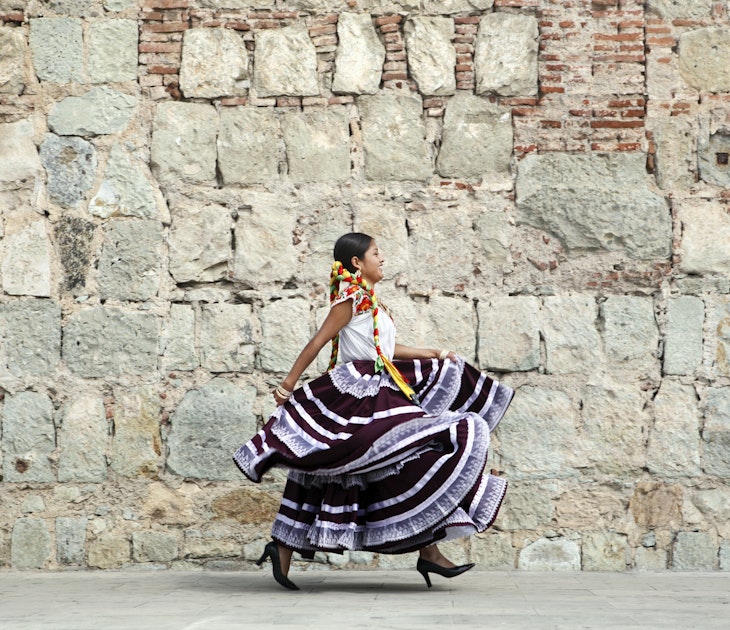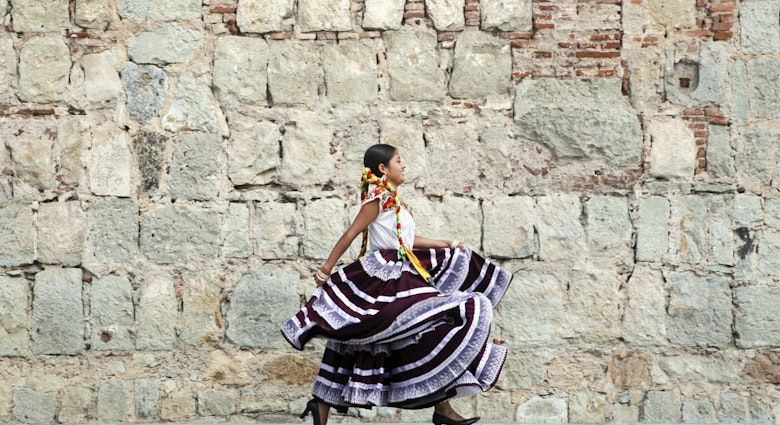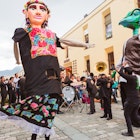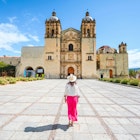The Oaxaca Coast is an independent traveler’s dream come true: a dramatic, near-empty shoreline with long golden beaches and lagoons full of wildlife, dotted with fishing villages, bohemian enclaves, surf towns and mellow resorts.
The lush Sierra Madre del Sur mountains serve as a backdrop to the coast, and act as a buffer to everything (and everyone) else, their endless hairpin turns making the 150-mile trip from Oaxaca City a day-long ordeal. For those who make the journey, the reward is multifold – paradisiacal beaches, world-class surfing swells and snorkeling from the shore, as well as nesting turtles and whale watching. All that plus the Oaxaca Coast’s famously laid back vibe, inviting you to disconnect, slow down and stay awhile.
When should I go to the Oaxaca Coast?
It’s hard to beat the weather on the Oaxaca Coast. The climate is temperate year-round, with daytime temperatures averaging 27°C (80°F) and evenings rarely dropping below 21°C (70°F); the ocean water, too, hovers in the mid 20s.
There also are just two seasons. From November to April, the dry season brings blue skies, windy days and virtually no clouds. Christmas, New Year and Semana Santa (the week before Easter) are peak travel times, when beaches are busy, bars are full and yoga retreats are in full swing. Hotel prices spike too. Whale watching is best from December to March.
Between May and October, the rainy season brings afternoon and early evening showers, though they’re typically short-lived and the sun makes an almost daily appearance. This is prime time for surfers, when the waves are big and consistent, and Puerto Escondido hosts international surf competitions on its monster break at Playa Zicatela.
In September and October, the rain gets heavier, and traveler numbers drop dramatically. Deals can be had, but some businesses close shop. Hurricanes can threaten the coast in the fall – check the weather forecast and heed warnings. This is turtle-nesting season too.

Is it easy to get to and around the Oaxaca Coast?
Hemmed in by the rugged Sierra Madre del Sur mountains, with just two highways in and out, the Oaxaca coast can be difficult to reach. The easiest but most expensive way to arrive is by air. Bahías de Huatulco International Airport is the main coastal airport; it has direct flights to and from several Mexican, US and Canadian cities.
Puerto Escondido’s Aeropuerto Internacional primarily handles flights from Mexico City. If you’re looking to fly from Oaxaca City, AeroTucan and AeroVega are your only options. The planes are tiny (six to eight seats), and luggage is limited to 15kg (33lbs), but the flight takes just 30 to 45 minutes to either airport.
By land, the coast is connected to Oaxaca’s interior by two winding, and often precarious, mountain roads. Neither is quick. Though a gorgeous jungley road, the trip is notorious for its countless vomit-inducing switchbacks; pack Dramamine, even if you don’t normally get carsick.
From Oaxaca City, bank on a journey of six to seven hours in a rental car or eight to nine hours in an often-packed camioneta (passenger minivan). First-class buses ply a slower round-about route via Salina Cruz; it takes around nine to 11 hours, but the ride is much smoother and more comfortable, with reclining seats, WiFi and bathrooms on board.
There's no Uber here, but exploring along the coast is relatively easy via pasajeros (pickup trucks with benches in back), colectivos (shared taxis) and private taxis . All can be flagged down along the main coastal road (Hwy 200) and in more populated places like Puerto Escondido, Pochutla and Huatulco. Most have their destinations written on the windshield.
A rental car offers more freedom and comfort, but doesn’t come cheap. Agencies can be found at the two airports and their nearby towns.

Why should I visit the Oaxaca Coast?
The Oaxaca Coast is like no other place in Mexico – a string of small beach towns and fishing villages with a laid-back, boho-hippy vibe that attracts backpackers and surfers plus New Agey types.
The setting couldn’t be more inspiring: miles and miles of dramatic beaches backed by the verdant Sierra Madre del Sur mountains, the coastal waters full of dolphins, turtles and migrating whales. And while some of Oaxaca’s beaches front surf towns and expat enclaves, most lie hidden from view, down a dirt road or at the end of a leafy path – just another way that Oaxaca delights and surprises, even as you relax and unwind.
A 15-mile-stretch of curlicue coastline, with nine bays and a whopping 36 beaches, Bahías de Huatulco is by no means plain, but it is the easiest section of the Oaxaca Coast to explore. Take taxis or splurge on a car rental, and don’t forget your gear – many of Huatulco’s beaches have healthy reefs and calm turquoise waters, making for excellent snorkeling from shore.
If you’re short on time, head towards the Parque Nacional Huatulco, starting at the family-friendly Bahía Maguey and beach-hopping your way to the dreamy Bahía Cacaluta, a long curving beach backed by golden dunes you’re likely to have all to yourself.
The Oaxaca Coast also boasts some of the best surfing spots in the country – Chacahua and Barra de la Cruz have point breaks peeling for hundreds of meters. Playa Zicatela’s Mexican Pipeline is unmissable, with monster tubes and walls 9m (30ft) high; even non-surfers come to watch the expert wave-riders do their thing.
If you’re looking to learn, surfboard rentals and a local instructor can be found in virtually every town. Surf camps also dot the coastline, providing lessons from dreadlocked pros and an instant community of like-minded travelers.
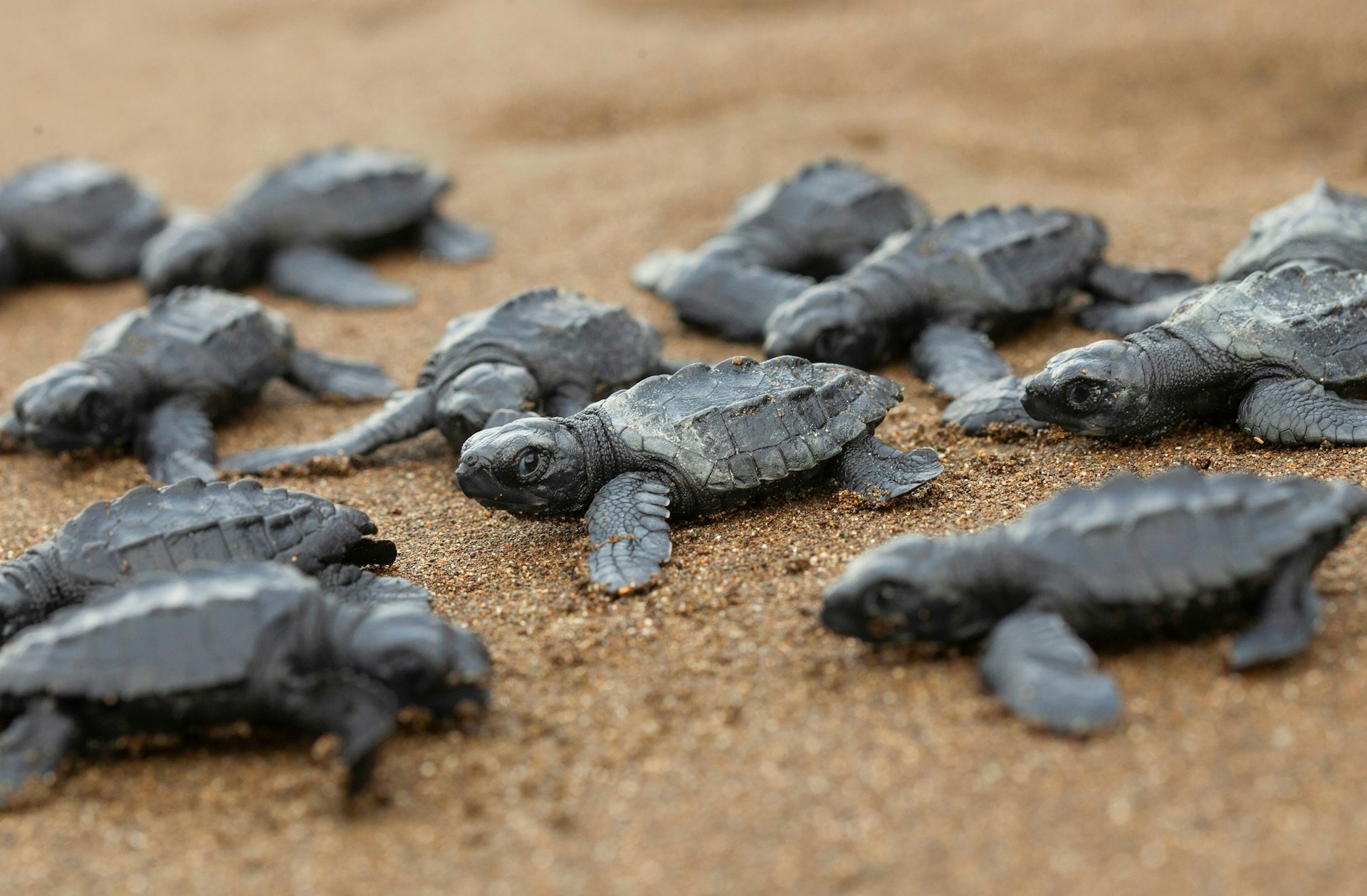
My favorite thing to do on the Oaxaca Coast
Watching an arribada on Playa Escobilla is, far and away, my favorite thing to do on the Oaxaca Coast. It’s the mass arrival of nesting olive ridley turtles, a phenomenon that happens around the full moon from July to January – and unlike anything I’ve ever seen.
The ocean waters are dotted with thousands of turtle heads, like a crowd of swimmers waiting to come in. The beach fills with countless more turtles, as far as the eye can see: a landscape of turtles, like slow-moving rocks, pulling themselves through the sand, digging nests with their flippers and at long last, laying their ping-pong-ball-shaped eggs.
The olive ridleys return here year after year, somehow drawn back to the same sand where they once hatched. Looking out over this living breathing beachscape, it’s a lesson in the power of a place, the pull of Oaxaca.
How do you say the name?
Oaxaca is pronounced "wah-HA-kah."
Is the Oaxaca Coast safe?
The Oaxaca Coast is a safe place to travel overall. Like most places in the world, though, petty thefts can happen, so only carry what you need, leave your valuables locked in your hotel and avoid flashing expensive phones and jewelry.
Violent crimes, especially against tourists, are rare. Nevertheless, avoid wandering alone at night and be aware of your surroundings. Drowning is actually the most common danger here; beware of undertows and riptides at ocean beaches and heed water safety flags. Know your limits – monster breaks like the Mexican Pipeline can be dangerous for novice surfers.
How many days should I plan on staying?
Plan on at least four days on the Oaxaca Coast, to just chill out and enjoy the beaches. The travel alone can wipe you out, especially if you arrive by land. For even more beach time, and to surf, snorkel and take a boat excursion, a week is ideal. Add more time for exploring the coastline or leaning into the slower rhythm of life.
What should I wear?
There’s no need for winter jackets or wetsuits on the Oaxaca Coast, ever. Pack for a beach vacay – flips flops, a couple swimsuits, casual street clothes, a billed hat. Bring a light sweater and pants for breezy nights or to keep the mosquitos off of you in the evenings. If you’re here during the rainy season, you’ll want a raincoat or an umbrella.
How much money do I need for the Oaxaca Coast?
The Oaxaca Coast is one of the least expensive beach destinations in Mexico. The cost of meals, accommodations and excursions is markedly less than beach destinations along the Riviera Maya and the Riviera Nayarit.
However, less expensive also means less infrastructure – the roads are often potholed or unpaved, WiFi can be spotty, ATMs are scarce (and often empty) and taking public transportation means flagging down a pickup truck and climbing in. Sure, you can find boutique hotels and specialty restaurants, but simple thatch-roofed hotels and mom-and-pop eateries are the norm – and that’s exactly the charm.
Can I use my credit card?
Cash is king on the Oaxaca Coast. Credit cards are not very useful for day-to-day purchases – many businesses, especially in villages, don’t accept them (and if they do, they’ll often tag on a 5 to 6% retailers' fee). Do carry plastic for resorts and high end hotels, car rentals and to buy airline and first-class bus tickets.
Should I bring my ATM card?
ATM cards are useful. However, outside of the bigger towns like Puerto Escondido, La Crucecita and Pochutla, ATMs are scarce and often empty. If you’ll be staying in smaller villages, take out larger sums of cash at one of the airports or in the bigger towns so you don’t end up in a bind.
Daily costs
- Hostel (dorm bed): M$200–300
- Basic room for two: from M$700
- Self-catering apartment (including Airbnb): from M$1000
- Taxi (in town): M$30–50
- Pasajero ride: M$7–15
- Liter of bottled water: M$14
- Beer on the beach: M$20
- Street taco: M$9
- Dinner for two: M$200–450
- Surf board rental (per hour): M$100
- Drop-in yoga class: M$60
You might also like:
The quest to revive Oaxaca’s centuries-old mountain trails one hike at a time
Beach boho vibes without the crowds: why we love Mexico's Central Pacific Coast
The best places to visit in Mexico for culture, cuisine and cenotes


